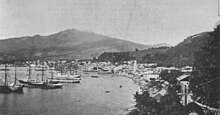This article possibly contains original research. (May 2024) |


The eruption of Mount Pelée on May 8, 1902 generated a pyroclastic flows, also known as nuées ardentes (Fr: burning clouds) cloud famous for having destroyed in a few minutes the town of Saint-Pierre, Martinique, at the time the administrative and economic capital of Martinique.
During this eruption, many boats were in the bay of Saint-Pierre. Like the city, they were destroyed in an instant. The majority caught fire and destroyed their bodies and property.[1][2][3][4][5]
The fishermen knew the locations of some of the wrecks. They sometimes blocked their nets and were areas rich in fish. With the advent of scuba diving in the 1970s, wreck hunters set out in search of sunken boats. Michel Météry is known to be the main inventor of most of these wrecks. Jacques Cousteau, Albert Falco and Dominique Serafini on the Calypso were also among those who searched for them.
These boats are now very attractive diving sites for divers who live or come to Martinique. All local diving clubs organize many trips to these sites. The Roraima, by its size and the quality of conservation, is the most emblematic of these wrecks. The Tamaya is the most mysterious because it is too deep for air diving.[6] The Grappler with his "treasure" is still sought after.
To preserve these cultural and heritage assets of Martinique, in 2012 the city of Saint-Pierre and the French state took the decision to protect the wrecks resting in the harbor of Saint-Pierre.[7]
The Frank-A.-Perret Museum of the City of Saint-Pierre recently launched a podcast in French dedicated to the wrecks located in the harbor Saint-Pierre. This podcast highlights various speakers, presented in alphabetical order: Mathurin Cadenet, originally from Saint-Pierre (nicknamed "Pierrotin"); Daniel Eustache, also Pierrotin and fisherman; Jean-Sébastien France, diver and president of the Association for Research and Valorization of the Archaeological Heritage of Martinique (ARVPAM); and Michel Météry, diver and discoverer of the wrecks in the harbor of Saint-Pierre.
- ^
Météry, Michel (2002). Tamaya: les épaves de Saint-Pierre (in French). Paris. ISBN 978-2-903581-30-5.
{{cite book}}: CS1 maint: location missing publisher (link) - ^ Météry, Michel (2002). Tamaya: les épaves de Saint-Pierre. Paris: Inst. Océanographique. ISBN 9782268071831.
- ^ Denhez, Frédéric (1997). Les épaves du volcan : Saint-Pierre de la Martinique. GLENAT. ISBN 9782723424622.
- ^ SERAFINI, Dominique (2015). Saint-Pierre l'Escale Infernale: TragédieMaritime - Éruption du Mont Pelé - Martinique 1902. S.QuemereImbert.
- ^ Ramadier, Sylvie (May 2005). "Le 8 mai 1902 saint pierre est enseveli sous la lave".
- ^ Imbert, Jean-Yves (June 1, 2016). "Tamaya un classique de la teck en Martinique". Plongé !. 3: 98.
- ^ "Zones de protections des épaves historiques de Saint-Pierre" (administrative document). 19 May 2022.